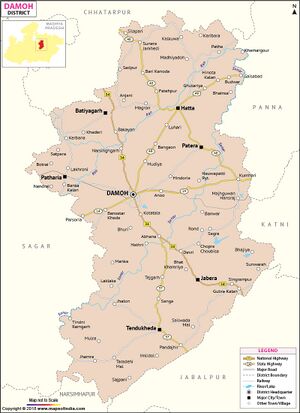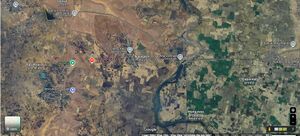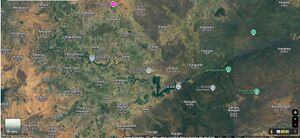Tharraka
| Author:Laxman Burdak, IFS (R) |



Tharraka (ठर्रका) is a deserted village, 15 miles from Damoh near the village Nayagaon, in Jabera tahsil in Damoh district of Madhya Pradesh.
Variants
Location
Nayagaon is a small Village/hamlet in Jabera Tehsil in Damoh District of Madhya Pradesh State, India. It comes under Nayagaon Panchayath. It belongs to Sagar Division . It is located 40 KM towards East from District head quarters Damoh. Nayagaon is surrounded by Damoh Tehsil towards west , Majhouli Tehsil towards East , Tendukheda Tehsil towards west , Bahoriband Tehsil towards East.[1]
Origin
Jat Gotras Namesake
- Tharua (ठरऊआ) (Jat clan) → Tharraka (ठर्रका). Tharraka (ठर्रका) is a deserted village, 15 miles from Damoh near the village Nayagaon, in Jabera tahsil in Damoh district of Madhya Pradesh. It is find place of an important inscription - (112) Tharraka Sati Inscriptions of 1513 AD.[2]. This inscription helps to derive the Origin of name of Singorgarh from Shrigauri-gadha (श्रीगौरी-गढ़). The theory of origin of name Singorgarh from Gajasimhadurga by Alexander Cunningham and other archaeologists has been proved wrong by (112) Tharraka Sati Inscriptions of 1513 AD. Tharraka (ठर्रका) contains five Sati pillars reoffering to the Gond regime. One is dated in samvat 1570 (1513 AD) during the reign of Amhandasadeva (आम्हणदासदेव) surname Sangram Sahi (संग्राम साही), the greatest king of the Gond dynasty. It mentions Tharraka (ठर्रका) as included in Shrigadha Gauri Vishaye Durge (श्रीगढ़ गौरी विषये दुर्गे), which furnishes a clue to the real derivation of Singoragadha fort from Shrigauri-gadha (श्रीगौरी-गढ़), fancifully derived by Cunningham from Gajasimha Durga, a name which appears to have been imposed by a Parihara Raja Gajasmha, but the old name asserted itself when the Parihara rule vanished. [3]
History
(112) Tharraka Sati Inscriptions of 1513 AD
Source - Inscriptions in the Central Provinces and Berar by Rai Bahadur Hira Lal, Nagpur, 1932,p.61
[p.61]: Tharraka (ठर्रका) is a deserted village, 15 miles from Damoh near the village Nayagaon. It contains five Sati pillars reoffering to the Gond regime. One is dated in samvat 1570 (1513 AD) during the reign of Amhandasadeva (आम्हणदासदेव) surname Sangram Sahi (संग्राम साही), the greatest king of the Gond dynasty. It mentions Tharraka (ठर्रका) as included in Shrigadha Gauri Vishaye Durge (श्रीगढ़ गौरी विषये दुर्गे), which furnishes a clue to the real derivation of Singoragadha fort from Shrigauri-gadha (श्रीगौरी-गढ़), fancifully derived by Cunningham from Gajasimha Durga, a name which appears to have been imposed by a Parihara Raja Gajasmha, but the old name asserted itself when the Parihara rule vanished. The second Sati stone is dated in samvat 1571 (=1514 AD), in which the name of the ruling king is given as Amanadasa (अमानदास). Two others are dated in samvat 17-7 and 1736 (=1679 AD), in the reign of Gond King Chhattra Sahi. The fifth is illegible.
Wiki Editor Note:
- Tharua (ठरऊआ) (Jat clan) → Tharraka (ठर्रका). Tharraka (ठर्रका) is a deserted village, 15 miles from Damoh near the village Nayagaon, in Jabera tahsil in Damoh district of Madhya Pradesh. It is find place of an important inscription - (112) Tharraka Sati Inscriptions of 1513 AD.[4]. This inscription helps to derive the Origin of name of Singorgarh from Shrigauri-gadha (श्रीगौरी-गढ़). The theory of origin of name Singorgarh from Gajasimhadurga by Alexander Cunningham and other archaeologists has been proved wrong by (112) Tharraka Sati Inscriptions of 1513 AD. Tharraka (ठर्रका) contains five Sati pillars reoffering to the Gond regime. One is dated in samvat 1570 (1513 AD) during the reign of Amhandasadeva (आम्हणदासदेव) surname Sangram Sahi (संग्राम साही), the greatest king of the Gond dynasty. It mentions Tharraka (ठर्रका) as included in Shrigadha Gauri Vishaye Durge (श्रीगढ़ गौरी विषये दुर्गे), which furnishes a clue to the real derivation of Singoragadha fort from Shrigauri-gadha (श्रीगौरी-गढ़), fancifully derived by Cunningham from Gajasimha Durga, a name which appears to have been imposed by a Parihara Raja Gajasmha, but the old name asserted itself when the Parihara rule vanished. [5]
दमोह के ठर्रका गांव में मिले दो शिलालेख
पंद्रहवी शताब्दी राजनीतिक अस्थिरता और विघटन की शताब्दी थी। तैमूर के आक्रमण के आघात से दिल्ली सल्तनत हिल गई थी। आने वाले कई दशकों तक सल्तनत लड़खड़ाती रही। इसी शताब्दी के प्रारंभ में प्रांतीय राज्यों का उदय हुआ। मालवा, बंगाल, खानदेश, गुजरात, दिल्ली सल्तनत से पूर्ण स्वतंत्र हो चुके थे। दक्षिण में बहमनी और विजयनगर राज्य पहले ही अस्तित्व में आ चुके थे। इसी दौर में सशक्त गोंडवाना की बुनियाद रखी गई। संग्रामशाह का नाम आम्हणदास भी था। दमोह के ठर्रका गांव में मिले दो शिलालेख से स्पष्ट है कि उनका शासनकाल 1510 से प्रारंभ हुआ, जो करीब 33 वर्षों तक चला। इसके बाद उनके पुत्र दलपतशाह ने गोंडवाना की कमान संभाली। दलपतशाह के बाद रानी दुर्गावती ने 1564 तक गोंडवाना की धरती को दुश्मनों से सुरक्षित रखा।
राजा संग्रामशाह ने अपने बाहुबल से गोंडवाना की सीमाएं 52 गढ़ों तक पहुंचाईं। गोंडवाना के अंदर बालाघाट, मंडला, डिंडौरी, सिवनी, छिंदवाड़ा, नरसिंहपुर, कटनी, दमोह, सागर, भोपाल, रायसेन, होशंगाबाद, हरदा, पन्ना जिले का दक्षिणी भाग, बिलासपुर जिले के पश्चिम में परताबगढ़, पंडरिया से लेकर लाफागढ़ का क्षेत्र रहा। महाराष्ट्र में नागपुर में कन्हान और पेंच नदियों के पूर्व का भाग, भंडारा जिला गोंडवाना में रहा। राजनांदगांव जिले का वह भाग जिसमें खैरागढ़ रियासत और खलौटी शामिल रहा। इस दौरान गढ़ा राज्य का विस्तार पूर्व से पश्चिम में 475 किलोमीटर और उत्तर से दक्षिण 390 किलोमीटर रहा।
संग्रामशाह के समय के सोने, चांदी और तांबे के सिक्के चलन में थे, इससे स्पष्ट है कि गोंडवाना आर्थिक रूप से समृद्ध रहा। डा. हीरालाल के अनुसार सोने व सिक्कों पर खड़े हुए सिंह का अंकन है। परंपरा के अनुसार गोंडवाना के शासकों का राजचिन्ह हाथी को दबोचे हुए सींग वाला शेर था। शहर के राजा गोकुलदास महल और कोतवाली थाना में इन राजचिन्हों को देखा जा सकता है।
श्रीगौरी-गढ़
ठर्रका: दमोह जिले कि जबेरा तहसील में नयागांव के पास ठर्रका नामक गांव में मिले संवत 1570 (1513 ई.) के सती शिलालेख में गोंड राजा संग्राम शाह को आम्हणदासदेव लिखा है. इस शिलालेख में ठर्रका गाँव को 'श्रीगढ़गौरी विषये दुर्गे' के अंतर्गत बताया गया है. इससे यह प्रमाणित होता है कि सिंगौरगढ़ किले का प्राचीन नाम श्रीगौरी-गढ़ था.[6]
External links
References
- ↑ https://www.onefivenine.com/india/villages/Damoh/Jabera/Nayagaon
- ↑ Inscriptions in the Central Provinces and Berar by Rai Bahadur Hira Lal, Nagpur, 1932,p.61
- ↑ Hiralal's Damoh Dipaka, 2nd edition, page 81
- ↑ Inscriptions in the Central Provinces and Berar by Rai Bahadur Hira Lal, Nagpur, 1932,p.61
- ↑ Hiralal's Damoh Dipaka, 2nd edition, page 81
- ↑ Inscriptions in the Central Provinces and Berar by Rai Bahadur Hira Lal, Nagpur, 1932,p.61

